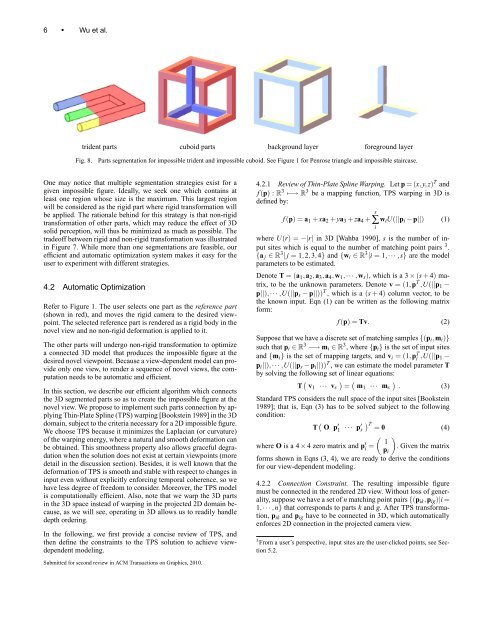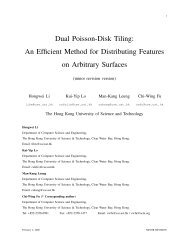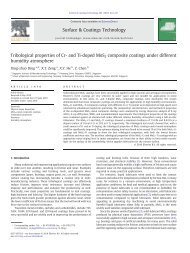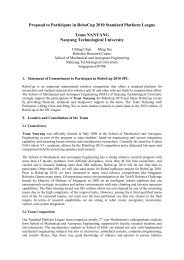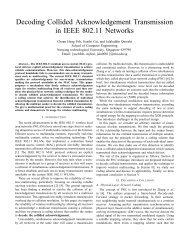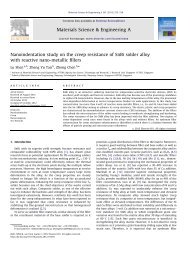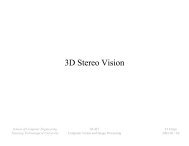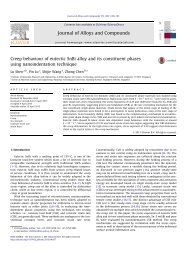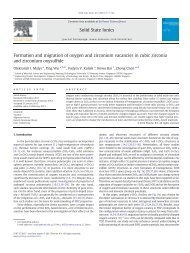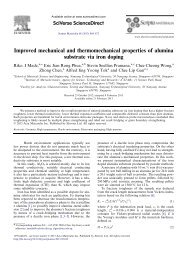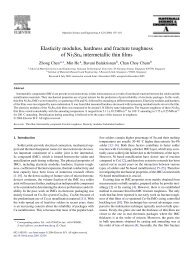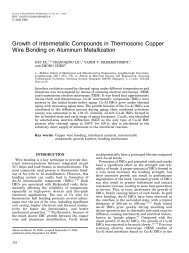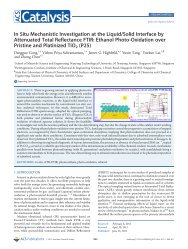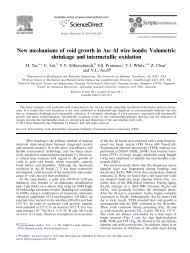ifrender - Nanyang Technological University
ifrender - Nanyang Technological University
ifrender - Nanyang Technological University
You also want an ePaper? Increase the reach of your titles
YUMPU automatically turns print PDFs into web optimized ePapers that Google loves.
6 • Wu et al.<br />
trident parts cuboid parts background layer foreground layer<br />
Fig. 8. Parts segmentation for impossible trident and impossible cuboid. See Figure 1 for Penrose triangle and impossible staircase.<br />
One may notice that multiple segmentation strategies exist for a<br />
given impossible figure. Ideally, we seek one which contains at<br />
least one region whose size is the maximum. This largest region<br />
will be considered as the rigid part where rigid transformation will<br />
be applied. The rationale behind for this strategy is that non-rigid<br />
transformation of other parts, which may reduce the effect of 3D<br />
solid perception, will thus be minimized as much as possible. The<br />
tradeoff between rigid and non-rigid transformation was illustrated<br />
in Figure 7. While more than one segmentations are feasible, our<br />
efficient and automatic optimization system makes it easy for the<br />
user to experiment with different strategies.<br />
4.2 Automatic Optimization<br />
Refer to Figure 1. The user selects one part as the reference part<br />
(shown in red), and moves the rigid camera to the desired viewpoint.<br />
The selected reference part is rendered as a rigid body in the<br />
novel view and no non-rigid deformation is applied to it.<br />
The other parts will undergo non-rigid transformation to optimize<br />
a connected 3D model that produces the impossible figure at the<br />
desired novel viewpoint. Because a view-dependent model can provide<br />
only one view, to render a sequence of novel views, the computation<br />
needs to be automatic and efficient.<br />
In this section, we describe our efficient algorithm which connects<br />
the 3D segmented parts so as to create the impossible figure at the<br />
novel view. We propose to implement such parts connection by applying<br />
Thin-Plate Spline (TPS) warping [Bookstein 1989] in the 3D<br />
domain, subject to the criteria necessary for a 2D impossible figure.<br />
We choose TPS because it minimizes the Laplacian (or curvature)<br />
of the warping energy, where a natural and smooth deformation can<br />
be obtained. This smoothness property also allows graceful degradation<br />
when the solution does not exist at certain viewpoints (more<br />
detail in the discussion section). Besides, it is well known that the<br />
deformation of TPS is smooth and stable with respect to changes in<br />
input even without explicitly enforcing temporal coherence, so we<br />
have less degree of freedom to consider. Moreover, the TPS model<br />
is computationally efficient. Also, note that we warp the 3D parts<br />
in the 3D space instead of warping in the projected 2D domain because,<br />
as we will see, operating in 3D allows us to readily handle<br />
depth ordering.<br />
In the following, we first provide a concise review of TPS, and<br />
then define the constraints to the TPS solution to achieve viewdependent<br />
modeling.<br />
Submitted for second review in ACM Transactions on Graphics, 2010.<br />
4.2.1 Review of Thin-Plate Spline Warping. Let p = (x,y,z) T and<br />
f(p) : R 3 ↦−→ R 3 be a mapping function, TPS warping in 3D is<br />
defined by:<br />
s<br />
f(p) = a1 + xa2 + ya3 + za4 + ∑wiU(||pi − p||) (1)<br />
i<br />
where U(r) = −|r| in 3D [Wahba 1990], s is the number of input<br />
sites which is equal to the number of matching point pairs 3 .<br />
{a j ∈ R 3 | j = 1,2,3,4} and {wi ∈ R 3 |i = 1,··· ,s} are the model<br />
parameters to be estimated.<br />
Denote T = (a1,a2,a3,a4,w1,··· ,ws), which is a 3 ×(s+4) matrix,<br />
to be the unknown parameters. Denote v = (1,p T ,U(||p1 −<br />
p||),··· ,U(||ps − p||)) T , which is a (s + 4) column vector, to be<br />
the known input. Eqn (1) can be written as the following matrix<br />
form:<br />
f(p) = Tv. (2)<br />
Suppose that we have a discrete set of matching samples {(pi,mi)}<br />
such that pi ∈ R3 −→ mi ∈ R3 , where {pi} is the set of input sites<br />
and {mi} is the set of mapping targets, and vi = (1,pT i ,U(||p1 −<br />
pi||),··· ,U(||ps − pi||)) T , we can estimate the model parameter T<br />
by solving the following set of linear equations:<br />
T <br />
v1 ··· vs = m1 ··· ms . (3)<br />
Standard TPS considers the null space of the input sites [Bookstein<br />
1989]; that is, Eqn (3) has to be solved subject to the following<br />
condition:<br />
T O p ′ 1 ··· p′ T s = 0<br />
<br />
(4)<br />
. Given the matrix<br />
where O is a 4 × 4 zero matrix and p ′ i =<br />
<br />
1<br />
pi<br />
forms shown in Eqns (3, 4), we are ready to derive the conditions<br />
for our view-dependent modeling.<br />
4.2.2 Connection Constraint. The resulting impossible figure<br />
must be connected in the rendered 2D view. Without loss of generality,<br />
suppose we have a set of n matching point pairs {(pik,pig)|i =<br />
1,··· ,n} that corresponds to parts k and g. After TPS transformation,<br />
pik and pig have to be connected in 3D, which automatically<br />
enforces 2D connection in the projected camera view.<br />
3 From a user’s perspective, input sites are the user-clicked points, see Sec-<br />
tion 5.2.


